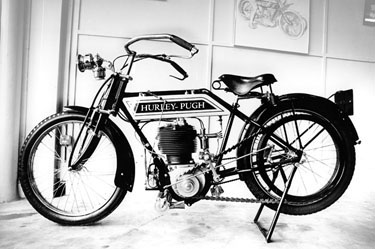


|
|

An early precursor of the Wildebeeste, Pugh's 948cc prototype of 1926, code-named after his favourite apprentice "Beryl", was recently re-discovered in an umbrella museum in Zagreb
It was in the Summer of 1934 that Alaric Pugh was seized by a dream: he would design the definitive motorcycle, refined enough to suit the most fastidious gentleman, advanced enough in engineering to satisfy the most particular scientist and fast enough to please the "brisk" rider.
He started with a clean sheet, discarding all the fragments of old and unsuitable engineering that, alas, figured in the output of all lesser motorcycle factories at the time. His conception was simple - a moderately large, robust engine, in a sensible state of tune, rigidly held as a load-bearing member in a frame of advanced design and enormous rigidity, suspended by the most developed shock-absorption systems imaginable and designed, from the outset, to form the backbone of a large family of models, sharing many parts across the entire range.
It is a tribute to his genius that Pugh settled on the revolutionary Model 34 engine as the basis for his new design - which he dubbed the "Wildebeeste". A 1234 cc eight-valve quadruple underhead camshaft single-cylinder four stroke with the unique Pugh Total Loss Lubrication System, driving a two-speed gearbox through a single-plate bakelite clutch and a quintuplex primary chain was not the obvious choice for a performance engine. The Model 34, however, once paired with the revolutionary "Pughspine" beam frame (with its highly advanced cast-iron monocoque construction), proved capable of a claimed output in excess of 137 horsepower at the crank, with a terrifying torque curve peaking at 47 rpm for ample supplies of "grunt". It would of course, effortlessly cruise along on a bare whiff of throttle - and the controls fell easily to hand, too!
The revolutionary Continental Touring wheels were held securely in the Patent Pugh Friction Damped Fork at the front end, with its revolutionary oval-section friction dampers and the Patent Pugh Rotary Damped Sidespring Thrunging Arm at the rear. This combination assured the expert rider of handling and nimbleness unlike any other motorcycle on the road at the time, although a certain amount of straight-line stability had, of necessity, to be sacrificed in favour of the ability to lean what, (984 lb for the basic Wildebeeste) was, after all, a substantial machine, into any corner of more that five degrees. The infinitely-adjustable steering geometry, achieved by the careful "fettling" of the precisely-calibrated brass rods and Rose Joints in the Patent Pugh Friction Damped Fork, allowed the setting of the machine's characteristics to suit all riding styles, although, in common with all Pugh's designs, a certain degree of mechanical competence on the part of the "fettler" was assumed.
Performance matched specification. The first speed trial of the prototype, which was undertaken in July 1934, after the return of "Killer" Steerforth from private business in Germany on 30 June 1934, was a triumph. The Wildebeeste boomed up to fully 183 miles per hour along the Measured Mile at Scunthorpe, according to factory records, and that evocative clanking, grinding Wildebeeste clatter resounded for the first time in the still Summer smog. An era was born.
The graet years began. The factory mounted annual challenges in the Tourist Trophy, using the famous Stage Sixteen Wildebeeste Manxmen - achieving two victories, although deprived of both by petty and small-minded officialdom. A seemingly endless succession of graet models, each a credit to the Grand Old Marque, rolled from the factory and into the hands of grateful cognoscenti of the motorcycle from all over the Empire. The Wildebeeste, the Tropical Wildebeeste, the Imperial Wildebeeste, the MkIII Wildebeeste Brooklands Manxman Thruxton, the Wildebeeste Manxman Brooklands Manxman Touring, the Wildebeeste Gentleman's Weatherman....
Where now are the innovations? The genius? The sheer inspiration? There is none. All the so-called sophistication of the modern, buzzing, plastic-bedecked cheap alloy motorcycle, no doubt designed by the same bureaux which gave the world the Zero fighter and the appalling Sony Walkman, has only served to produce a series of pale imitations of the glory which was Hurley-Pugh in the years of its strength: one merely needs to examine the "radical" ideas of some modern manufacturers: beam frames? The Wildebeeste. Rotary damping? The Wildebeeste. Chain oilers? The Wildebeeste (courtesy of the Total Loss Lubrication system).
The truth remains. The patriotic and sensible Englishman has no more choice today than he had in 1934. If he wants a proper motorcycle, he must ride a Hurley-Pugh.
"Oberon"
previous article | next article